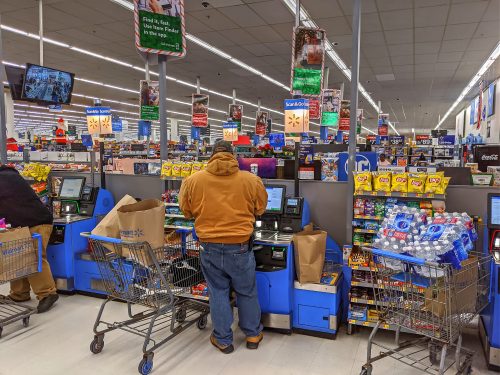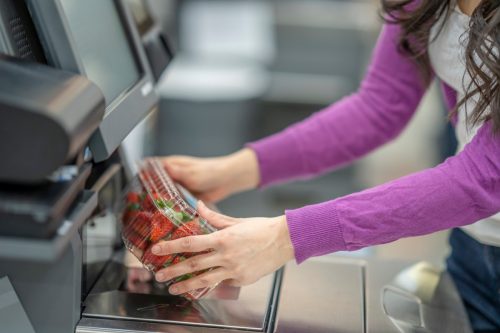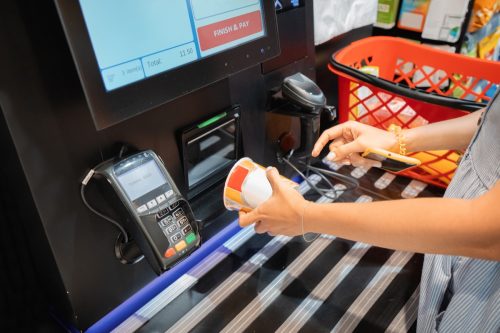5 Self-Checkout Mistakes That Are Costing You Big, Experts Warn

For a while, it seemed as though stores like Walmart and Costco were considering eliminating self-checkout due to customers’ complaints about malfunctioning machines and incorrect pricing. But it looks like the convenience of faster lines and less human interaction won out in the end. So, with the technology here to stay, we’re helping you ensure you’re not making any mistakes that’ll have you spending more money than you should be. To find out where you might be going wrong, read on for six self-checkout mistakes that will cost you big.
RELATED: Walmart Employees Issue Warning to Shoppers About Self-Checkout.
1. You’re not checking for skimmers before you pay.

Criminals will do whatever they can to get access to your financial accounts, including putting skimmers on card machines at major retailers.
But while cashiers can inspect their own readers, Michael Podolsky, CEO and co-founder of the consumer advocacy platform PissedConsumer.com, tells Best Life that shoppers forget to think about skimmers that could be attached to self-checkout machines.
“To safeguard one’s financial data, a consumer should take a brief moment to examine the machine for any unfamiliar attachments before payment,” Podolsky cautions.
Criminals have the most opportunity to install skimmers at self-checkouts because of the lack of workers, according to Marie Clark, a retail expert and editor of the shopping site CostContessa.
“Card scanners can happen at any store—even large and reputable stores like Costco or Target,” she says. In fact, it’s happened many times at Walmart stores.
“If you can’t use a digital payment, use a credit card over a [debit card] if possible, and check the card reader carefully,” Clark advises. “The plastic should be all one piece, and generally the card readers on all the self-checkout registers will look the same—so if yours looks different, that’s another red flag.”
2. You’re forgetting to double-check for price discrepancies.

Several major retailers have made headlines recently for overcharging issues, as customers have spotted price discrepancies or additional charges when using self-checkout machines. With that in mind, it’s good to be extra careful.
“Sometimes, the price on the shelf differs from the price at checkout,” Michael Wilson, a technology expert and the chief technology officer at EcoMotionCentral, says. “Always pay attention to the screen to ensure you’re charged correctly.”
RELATED: How Self-Checkout Is Making You Spend More, New Study Reveals.
3. You’re not watching every item get scanned.

Price-scanning errors are not the only reason you might end up being overcharged. As Clark explains, children often love scanning items themselves at the self-checkout. But if you’re letting them help out, you need to be supervising them through the entire process.
“Sometimes an item scan is delayed a second or two, and children can rescan it thinking it didn’t work and accidentally scan items twice,” Clark warns. “To ensure you don’t over- or underpay, watch kids and the items as they are added to ensure it’s been done accurately.”
Also, double-check your receipt to make sure you didn’t inadvertently scan something twice. In the past, Walmart shoppers have complained about self-checkout machines double-or triple-charging them for an item they only scanned once.
4. You’re not using your store card.

When you’re doing everything yourself, you don’t have someone there reminding you of the things you might forget—like using your rewards or points cards, Alex Veytsman, a wealth management expert and founder of The Offer Sheet, explains.
“Many grocery stores have cards that allow you to collect different rewards. At a regular checkout, the cashier will normally ask you for it, which means you don’t have to remember to have it ready all the time,” Veytsman notes. “At a self-checkout, it’s possible it might not ask you, so always remember to try and have it ready to scan. This way, you aren’t missing out on extra points, which can save you money on whatever rewards system they have.”
RELATED: 4 New Target Shopping Changes Coming to Stores This Month.
5. You’re blocking the camera’s view.

Most self-checkout machines have cameras that monitor shoppers through the entire process. They usually record what you’re scanning as well, according to Clay Cary, a consumer trends analyst and the lead analyst at CouponFollow.
But problems can arise when people accidentally block the camera’s view with their bags or bulky items—which happens more often than you might think.
“This can lead to disputes over purchases and create headaches for consumers and retailers alike,” Cary says. “So always ensure the camera has an unblocked view of the transaction, as clear video evidence can help resolve potential conflicts.”